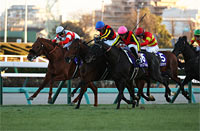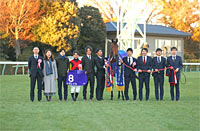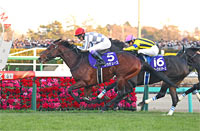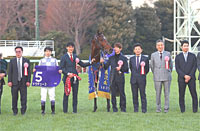Arima Kinen (The Grand Prix) (G1) - Data Analysis
Battle on Christmas Day
The Arima Kinen (The Grand Prix) is one of Japan’s most keenly watched sporting events. Every year, Nakayama Racecourse attracts far more spectators than any baseball or soccer game, the unique atmosphere setting the scene for a splendid climax to the racing year. This year’s contest will again see a lineup of top horses assembled from different routes in their quest for victory. First, let’s look at some trends in this race based on results over the last 10 years.
Dominance of 5-year-olds and under
Horses aged 5 and under have dominated the Arima Kinen over the last 10 years, with no 6-year-old finishing in either of the Top 2 places in that time. The only runner aged 7 or higher to do so was Admire Monarch (then aged 7) in 2008, while one such horse has finished 3rd on two occasions (Air Shady, when aged 7 and 8). In fact, the last Arima Kinen winner aged 6 or higher was Dai Yusaku in 1991 (then aged 6). [Table 1]
[Table 1] Performance by age (last 10 years)
| Age |
Performance
[1st-2nd-3rd-4th or lower] |
Win ratio |
Top 2 ratio |
Top 3 ratio |
| 3 |
3-3-2-27 |
8.6% |
17.1% |
22.9% |
| 4 |
4-4-2-28 |
10.5% |
21.1% |
26.3% |
| 5 |
3-2-3-35 |
7.0% |
11.6% |
18.6% |
| 6 |
0-0-1-18 |
0% |
0% |
5.3% |
| 7 and up |
0-1-2-13 |
0% |
6.3% |
18.8% |
Check the performance by win odds
Looking at aggregate performances over the last 10 years in terms of win odds, six of seven runners backed by odds of “2.9 or less” have finished in the Top 2 (the exception being Meisho Samson, 8th in 2007). Another characteristic trend is that no horse with odds in the “5.0-6.9” and “10.0-14.9” ranges has made it into the Top 3. By contrast, runners in the “7.0-9.9” range have posted good records, while odds of “20.0-49.9” have produced four runners-up and three 3rd place finishes – two points worth bearing in mind. [Table 2]
[Table 2] Performance by win odds (last 10 years)
| Win odds |
Performance
[1st-2nd-3rd-4th or lower] |
Win ratio |
Top 2 ratio |
Top 3 ratio |
| 2.9 or lower |
5-1-0-1 |
71.4% |
85.7% |
85.7% |
| 3.0-4.9 |
1-1-3-6 |
9.1% |
18.2% |
45.5% |
| 5.0-6.9 |
0-0-0-4 |
0% |
0% |
0% |
| 7.0-9.9 |
2-2-1-6 |
18.2% |
36.4% |
45.5% |
| 10.0-14.9 |
0-0-0-15 |
0% |
0% |
0% |
| 15.0-19.9 |
1-1-2-10 |
7.1% |
14.3% |
28.6% |
| 20.0-49.9 |
0-4-3-35 |
0% |
9.5% |
16.7% |
| 50 or more |
1-1-1-44 |
2.1% |
4.3% |
6.4% |
Look for a domestic or overseas Grade 1 race last time out
Turning to performances by runners over the last 10 years in terms of their previous race, the majority of Top 3 finishers had most recently contested a domestic or overseas Grade 1 race. Those coming straight from the “Japan Cup,” “Tenno Sho (Autumn)” and “Kikuka Sho (Japanese St. Leger)” have been particularly successful here. And while last year’s winner Gold Actor had previously contested the Grade 2 “Copa Republica Argentina,” it’s worth noting that three horses coming straight from “Counterclockwise Grade 2 races” (including Gold Actor) have finished in the Top 2, but that no horse last seen in a “Clockwise Grade 2 race” has made it into the Top 3. [Table 3]
[Table 3] Performance by previous race (last 10 years)
| Previous race |
Performance
[1st-2nd-3rd-4th or lower] |
Win ratio |
Top 2 ratio |
Top 3 ratio |
| Japan Cup |
3-4-4-53 |
4.7% |
10.9% |
17.2% |
| Tenno Sho (Autumn) |
3-0-1-6 |
30.0% |
30.0% |
40.0% |
| Kikuka Sho |
2-1-1-7 |
18.2% |
27.3% |
36.4% |
| Other domestic G1 |
0-2-2-12 |
0% |
12.5% |
25.0% |
| Overseas G1 |
1-1-1-5 |
12.5% |
25.0% |
37.5% |
| Counterclockwise G2 |
1-2-0-14 |
5.9% |
17.6% |
17.6% |
| Clockwise G2 |
0-0-0-12 |
0% |
0% |
0% |
| Other races |
0-0-1-12 |
0% |
0% |
7.7% |
Next, if we aggregate the performances of horses most recently seen in domestic or overseas Grade 1 races based on their finish in that race, we find that those placed “1st” there have tended to perform well here. An interesting point in this respect is that, while six runners have bounced back from a finish of “10th or lower” last time out, those placed “6th-9th” in that race have not done so well here. [Table 4]
[Table 4] Performance by finish in the last race when it was domestic or overseas G1 (last 10 years)
| Finish in last race |
Performance
[1st-2nd-3rd-4th or lower] |
Win ratio |
Top 2 ratio |
Top 3 ratio |
| 1st |
3-1-3-8 |
20.0% |
26.7% |
46.7% |
| 2nd |
2-2-0-9 |
15.4% |
30.8% |
30.8% |
| 3rd |
1-1-1-7 |
10.0% |
20.0% |
30.0% |
| 4th |
1-0-0-9 |
10.0% |
10.0% |
10.0% |
| 5th |
0-1-2-3 |
0% |
16.7% |
50.0% |
| 6th-9th |
1-1-0-23 |
4.0% |
8.0% |
8.0% |
| 10th or lower |
1-2-3-24 |
3.3% |
10.0% |
20.0% |
A change of rider may not be so bad
In the Arima Kinen of old, horses ridden by the same jockey as in their previous outing tended to perform better than those with a change of rider. But that appears not to have been the case recently; in both 2013 and 2014, horses with a change of rider monopolized the Top 3 places. We should hesitate to discount runners with a change of rider in this case. [Table 5]
[Table 5] Top 3 finishers with a change of rider (last 10 years)
| Year |
Finish |
Horse |
Jockey last time |
Jockey in the Arima Kinen |
| 2006 |
2nd |
Pop Rock |
Damien Oliver |
Olivier Peslier |
| 2007 |
3rd |
Daiwa Major |
Katsumi Ando |
Mirco Demuro |
| 2008 |
2nd |
Admire Monarch |
Katsumi Ando |
Yuga Kawada |
| 2009 |
2nd |
Buena Vista |
Katsumi Ando |
Norihiro Yokoyama |
| 2010 |
1st |
Victoire Pisa |
Maxime Guyon |
Mirco Demuro |
| 3rd |
To the Glory |
Mirco Demuro |
Craig Williams |
| 2011 |
2nd |
Eishin Flash |
Kenichi Ikezoe |
Christophe Lemaire |
| 2013 |
1st |
Orfevre |
Christophe Soumillon |
Kenichi Ikezoe |
| 2nd |
Win Variation |
Kota Fujioka |
Yasunari Iwata |
| 3rd |
Gold Ship |
Hiroyuki Uchida |
Ryan Moore |
| 2014 |
1st |
Gentildonna |
Ryan Moore |
Keita Tosaki |
| 2nd |
To the World |
Yuga Kawada |
William Buick |
| 3rd |
Gold Ship |
Norihiro Yokoyama |
Yasunari Iwata |
| 2015 |
3rd |
Kitasan Black |
Hiroshi Kitamura |
Norihiro Yokoyama |
Also check the last two outings
In the Arima Kinen over the last five years, “just one horse” coming from “a G2 race two races back and a G1 race last time out” has finished in the Top 2 in all five years. Even if we widen the net to the last 10 years, 2006 and 2010 were the only years when a runner with this kind of recent record did not finish in the Top 2. A characteristic trend in both cases is that “just one horse” made it into the Top 2. [Table 6]
[Table 6] Top 2 finishers in the Arima Kinen contesting a G2 race followed by a G1 race in their last two outings (last 10 years)
| Year |
Finish |
Horse |
Two races back |
Last race |
| 2007 |
1st |
Matsurida Gogh |
Sankei Sho All Comers |
1st |
Tenno Sho (Autumn) |
15th |
| 2008 |
1st |
Daiwa Scarlet |
Sankei Osaka Hai |
1st |
Tenno Sho (Autumn) |
2nd |
| 2009 |
1st |
Dream Journey |
Sankei Sho All Comers |
2nd |
Tenno Sho (Autumn) |
6th |
| 2011 |
1st |
Orfevre |
Kobe Shimbun Hai |
1st |
Kikuka Sho |
1st |
| 2012 |
1st |
Gold Ship |
Kobe Shimbun Hai |
1st |
Kikuka Sho |
1st |
| 2013 |
1st |
Orfevre |
Prix Foy |
1st |
Prix de l’Arc de Triomphe |
2nd |
| 2014 |
2nd |
To the World |
Asahi Hai St. Lite Kinen |
2nd |
Kikuka Sho |
16th |
| 2015 |
2nd |
Sounds of Earth |
Kyoto Daishoten |
2nd |
Japan Cup |
5th |
Seek out the winner!
Check the margins on victories over 2,400m+
All of the last five winners had previously experienced wins by at least one length in turf races over 2,400 meters or more within their previous four outings. This year, too, we should be looking out for horses coming with recent experience of comfortable wins in long-distance races. [Table 7]
[Table 7] Last five winners' record of winning 2,400m+ turf races by at least one length within their last four outings
| Year |
Winning horse |
Race in question |
| 2011 |
Orfevre |
last race |
Kikuka Sho |
Turf 3,000m |
2½ lengths |
| 2012 |
Gold Ship |
last race |
Kikuka Sho |
Turf 3,000m |
1¾ lengths |
| 2013 |
Orfevre |
2 races back |
Prix Foy |
Turf 2,400m |
3 lengths |
| 2014 |
Gentildonna |
4 races back |
Dubai Sheema Classic |
Turf 2,410m |
1½ lengths |
| 2015 |
Gold Actor |
2 races back |
October Stakes (3-win class) |
Turf 2,400m |
1¾ lengths |
*When there is more than one race in question, the most recent one is shown.
(Yasunori Asano)
|




















